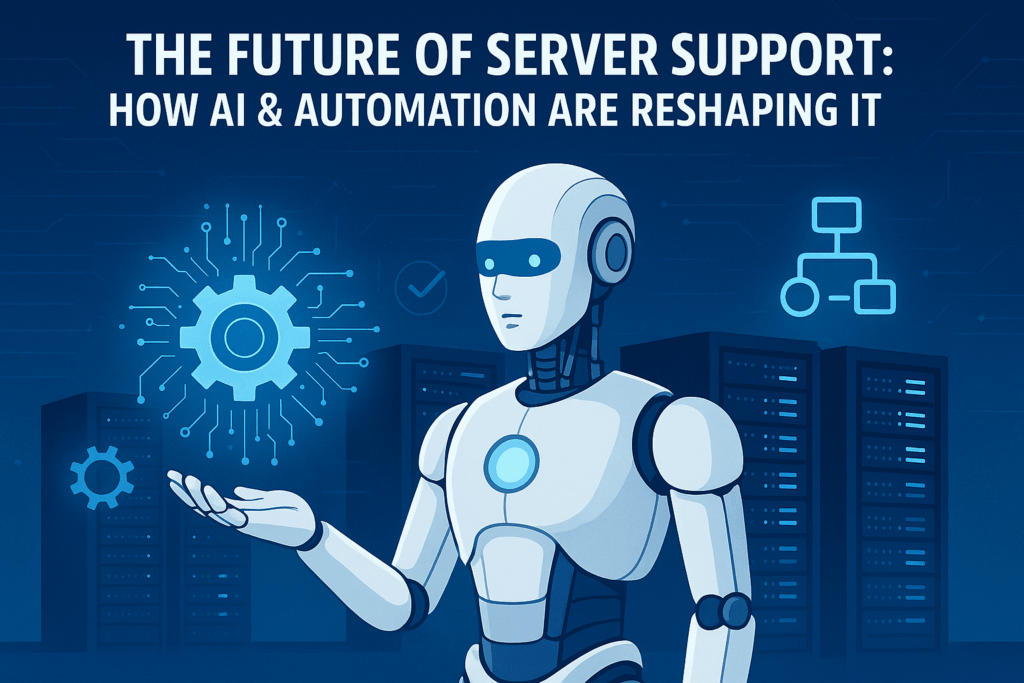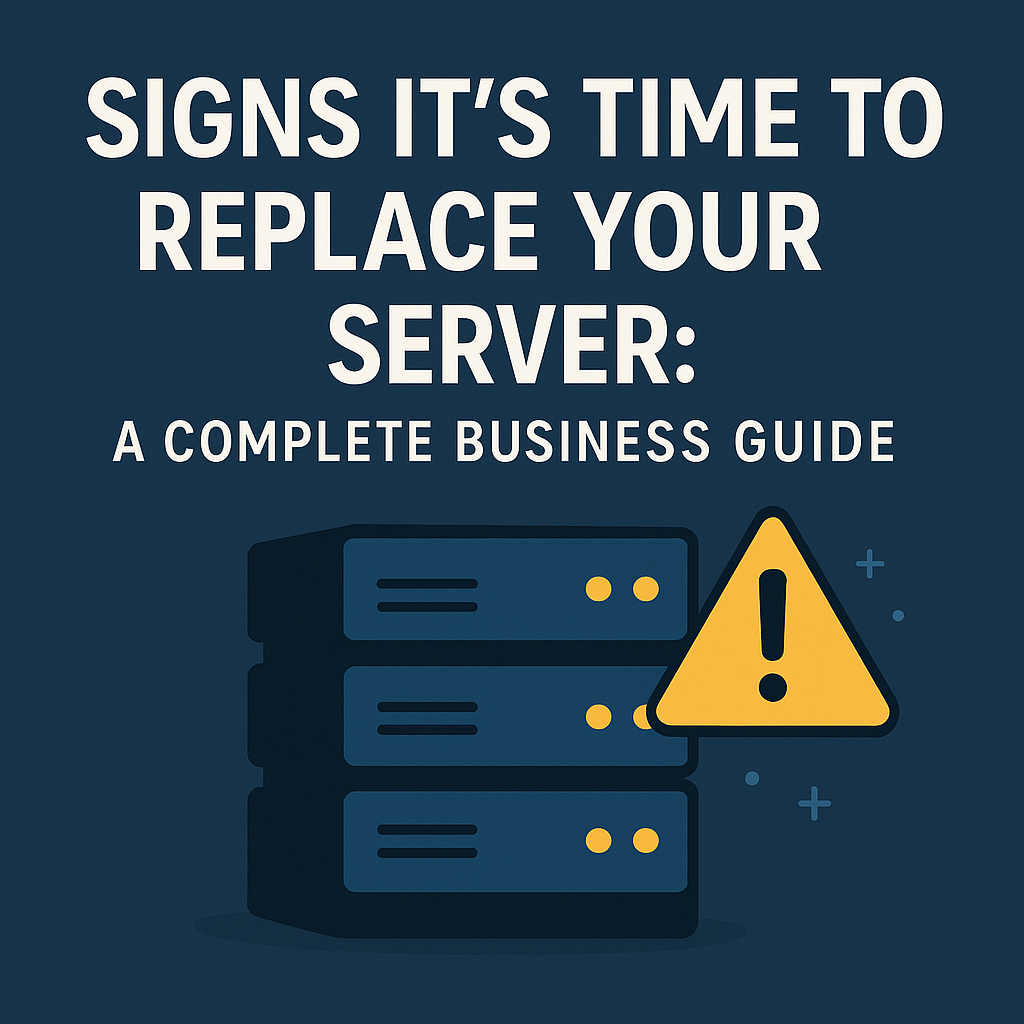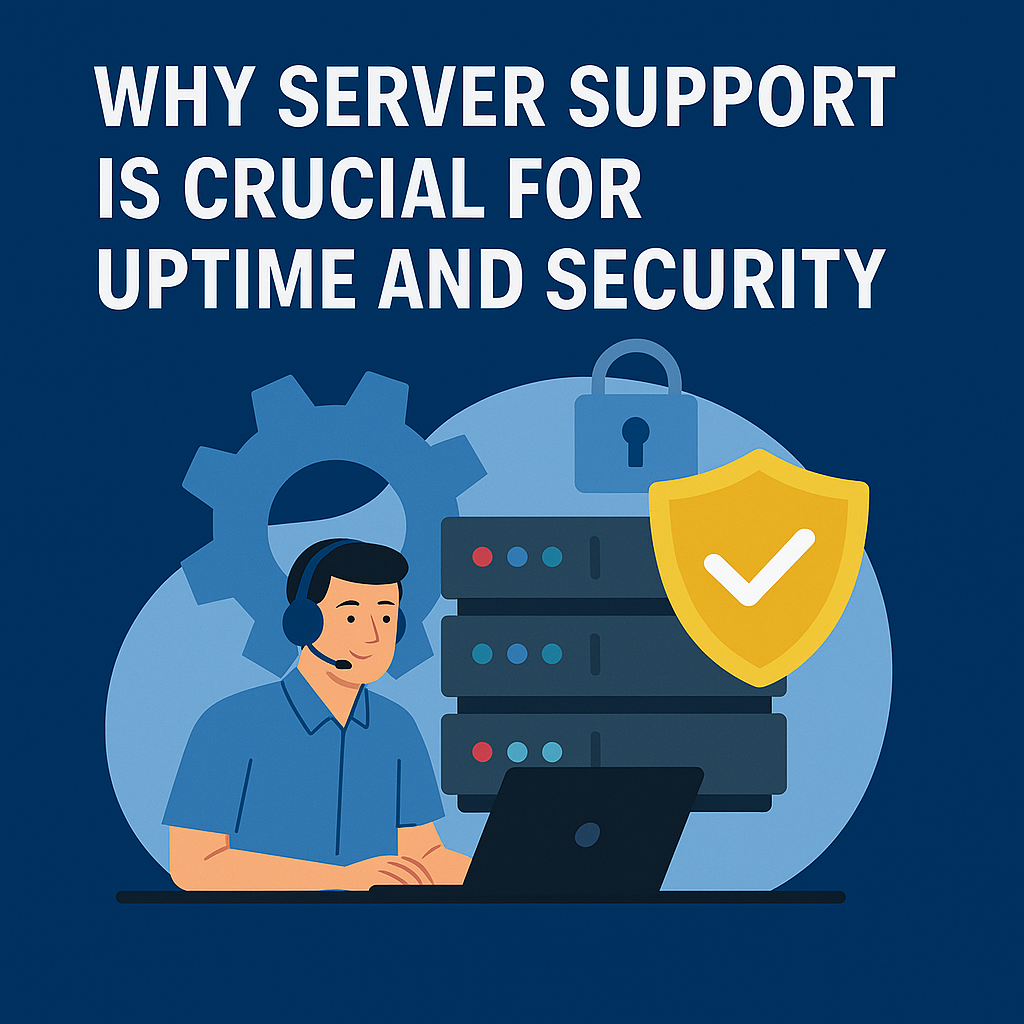The Future of Server Support: How AI & Automation Are Reshaping IT

The landscape of professional server support is experiencing a revolutionary transformation. As organizations grapple with increasingly complex digital infrastructures, traditional reactive support models are giving way to intelligent, proactive systems powered by artificial intelligence and automation. This shift represents more than just technological advancement—it’s a fundamental reimagining of how IT operations can achieve unprecedented efficiency, reliability, and scalability.
Understanding the Current Server Support Challenges
Modern IT environments face mounting pressures that traditional support models struggle to address effectively. Server downtime costs businesses an average of $5,600 per minute, while the complexity of hybrid cloud architectures continues to grow exponentially.
The Limitations of Traditional Support Models
Legacy server support systems rely heavily on manual intervention and reactive problem-solving. IT teams typically respond to issues after they occur, leading to extended downtime periods and frustrated end-users. This approach creates several critical bottlenecks when addressing any server problem.
Human-dependent monitoring systems often miss subtle performance indicators that could predict future failures. The manual nature of traditional support also means that resolution times vary significantly based on staff availability and expertise levels.
Furthermore, the increasing volume of alerts and notifications in modern IT environments leads to alert fatigue, where critical issues may be overlooked among less important notifications. This reactive approach ultimately results in higher operational costs and reduced system reliability.
The Growing Complexity of Modern IT Infrastructure
Today’s server environments encompass on-premises systems, public clouds, private clouds, and hybrid architectures. Each component requires specialized knowledge and monitoring approaches, creating complexity that exceeds human capacity to manage effectively without technological assistance.
Microservices architectures and containerized applications add additional layers of complexity, with interdependencies that can be difficult to map and monitor manually. The sheer volume of data generated by modern systems requires automated analysis to extract meaningful insights.
How AI is Revolutionizing Server Monitoring and Management
Artificial intelligence is transforming server support from a reactive discipline into a proactive, predictive science. Machine learning algorithms can analyze vast amounts of system data to identify patterns invisible to human operators. This evolution is particularly significant in the growing virtual private server market, where complexity and scale require intelligent automation.
Predictive Analytics and Proactive Issue Resolution
AI-powered monitoring systems continuously analyze server performance metrics, identifying subtle changes that indicate potential problems before they impact operations. These systems learn from historical data to improve their prediction accuracy over time.
Machine learning models can correlate seemingly unrelated events across different system components, revealing complex failure patterns that would be impossible for humans to detect manually. This capability enables IT teams to address issues during planned maintenance windows rather than during critical business hours.
Advanced AI systems can even suggest specific remediation steps based on similar historical incidents, significantly reducing mean time to resolution. The continuous learning aspect means that these systems become more effective as they process more data over time.
Intelligent Resource Allocation and Capacity Planning
AI algorithms excel at analyzing resource utilization patterns to optimize server performance and capacity planning. These systems can predict when additional resources will be needed and automatically scale infrastructure to meet demand.
Dynamic resource allocation based on real-time analysis helps organizations avoid both over-provisioning and under-provisioning scenarios. This optimization leads to significant cost savings while maintaining optimal performance levels.
Capacity planning becomes more accurate when AI systems analyze historical trends, seasonal patterns, and business growth projections simultaneously. This comprehensive analysis enables more informed infrastructure investment decisions.
Automation Technologies Transforming IT Operations
Automation complements AI capabilities by executing routine tasks and implementing solutions without human intervention. This combination creates a powerful synergy that dramatically improves operational efficiency.
Automated Incident Response and Resolution
Modern automation platforms can respond to common server issues within seconds of detection. These systems follow predefined workflows to resolve standard problems, escalating only complex issues that require human intervention. This capability is revolutionizing outsourced server support by providing consistent, rapid responses regardless of time zones or staffing levels.
Automated ticketing systems can categorize and prioritize incidents based on business impact and urgency levels. This intelligent routing ensures that critical issues receive immediate attention while routine matters are handled automatically.
Self-healing infrastructure represents the pinnacle of automated incident response, where systems can detect, diagnose, and resolve issues without any human involvement. This capability is particularly valuable for maintaining service levels during off-hours.
Infrastructure as Code and Configuration Management
Automation enables consistent server configurations through Infrastructure as Code practices. This approach eliminates configuration drift and ensures that all systems maintain their intended state over time.
Automated configuration management systems can detect unauthorized changes and either alert administrators or automatically revert to approved configurations. This capability significantly enhances security and compliance postures.
Version control for infrastructure configurations enables teams to track changes, roll back problematic updates, and maintain consistency across development, testing, and production environments.
The Benefits of AI-Driven Server Support
Organizations implementing AI and automation in their server support operations experience transformative improvements across multiple dimensions of IT service delivery. Modern server support services are evolving to incorporate these intelligent capabilities, providing enhanced value to businesses of all sizes.
Enhanced System Reliability and Uptime
AI-powered monitoring and predictive maintenance significantly reduce unplanned downtime by identifying and addressing issues before they impact operations. Systems can achieve uptime levels that were previously impossible with manual monitoring approaches.
Proactive maintenance scheduling based on AI predictions allows organizations to perform necessary updates and repairs during planned maintenance windows, minimizing business disruption.
Automated failover and recovery procedures ensure that service interruptions are brief and often transparent to end-users. This capability is crucial for maintaining business continuity in today’s always-on digital economy.
Cost Reduction and Resource Optimization
Intelligent automation reduces the need for round-the-clock human monitoring while improving response times and resolution quality. Organizations typically see significant reductions in operational expenses within months of implementation. This trend is driving growth in outsourced server monitoring solutions that combine AI capabilities with expert human oversight.
Optimized resource utilization through AI-driven capacity planning prevents over-provisioning while ensuring adequate performance levels. This balance results in substantial infrastructure cost savings.
Reduced incident frequency through predictive maintenance means fewer emergency support calls and less disruption to normal business operations. The cumulative effect of these improvements delivers impressive return on investment.
Improved Staff Productivity and Job Satisfaction
By automating routine tasks, AI and automation free IT professionals to focus on strategic initiatives and complex problem-solving. This shift typically leads to higher job satisfaction and better retention rates.
Staff members can develop new skills in AI and automation technologies, making them more valuable to their organizations and enhancing their career prospects. This professional development opportunity is increasingly important in competitive job markets.
The reduction in after-hours emergency calls and stress associated with reactive fire-fighting creates a better work-life balance for IT teams. This improvement contributes to better overall team performance and morale.
Implementation Strategies for AI and Automation
Successful adoption of AI and automation in server support requires careful planning, strategic thinking, and gradual implementation approaches that minimize disruption while maximizing benefits.
Assessing Current Infrastructure and Readiness
Organizations must evaluate their existing monitoring capabilities, data quality, and technical infrastructure before implementing AI solutions. This assessment identifies gaps that need addressing for successful deployment.
Data standardization and collection processes require review to ensure that AI systems have access to high-quality information. Poor data quality will severely limit the effectiveness of machine learning algorithms.
Staff readiness and training needs should be evaluated early in the planning process. Change management strategies must address both technical and cultural aspects of AI adoption.
Choosing the Right Tools and Platforms
The market offers numerous AI and automation platforms, each with different strengths and focus areas. Organizations should evaluate solutions based on their specific needs, existing technology stack, and long-term strategic goals.
Integration capabilities with existing monitoring and management tools are crucial for smooth implementation. Solutions that require complete infrastructure replacement are typically more disruptive and expensive.
Vendor evaluation should include considerations of support quality, development roadmaps, and financial stability. The chosen platform will likely be a long-term technology partner, making vendor selection particularly important.
Phased Implementation Approach
Most successful AI and automation implementations follow a phased approach that starts with less critical systems and gradually expands to more important infrastructure components.
Pilot projects allow organizations to gain experience with new technologies while minimizing risk. These initial implementations provide valuable lessons that inform broader deployment strategies.
Success metrics and key performance indicators should be established early to measure the effectiveness of AI and automation initiatives. Regular evaluation ensures that implementations deliver expected benefits and identify areas for improvement.
Challenges and Considerations
While AI and automation offer tremendous benefits for server support, organizations must navigate several challenges to achieve successful implementations.
Data Quality and Integration Issues
AI systems require high-quality, consistent data to function effectively. Organizations often discover data quality issues during implementation that require significant cleanup efforts.
Integration with legacy systems can present technical challenges that require custom development or middleware solutions. These integration projects can be complex and time-consuming, particularly in environments that include diverse database systems where the SQL server transformation market continues to evolve rapidly.
Data silos within organizations may prevent AI systems from accessing all relevant information needed for optimal performance. Breaking down these silos often requires organizational change in addition to technical solutions.
Skills Gap and Training Requirements
The shift to AI-driven server support requires new skills that many IT professionals may not currently possess. Organizations must invest in training programs to bridge these knowledge gaps, particularly in areas like server troubleshooting using AI-assisted tools and methodologies.
Finding and retaining staff with AI and automation expertise can be challenging in competitive job markets. Companies may need to offer competitive compensation packages and professional development opportunities.
Balancing automation with human expertise requires careful consideration of which tasks should be automated and which require human judgment. This balance evolves as AI capabilities improve over time.
Security and Compliance Considerations
AI systems require access to sensitive operational data, creating new security considerations that organizations must address. Proper access controls and data protection measures are essential.
Compliance requirements may dictate specific approaches to AI implementation, particularly in regulated industries. Understanding these requirements early in the planning process prevents costly redesign efforts.
Audit trails and explainability features become important when AI systems make decisions that affect business operations. Organizations must ensure they can demonstrate compliance with relevant regulations and internal policies.
Real-World Success Stories
Organizations across various industries have achieved remarkable results through strategic implementation of AI and automation in their server support operations.
Enterprise-Level Transformations
A major financial services company reduced server-related incidents by 75% after implementing AI-powered predictive monitoring across their global infrastructure. The system now identifies potential issues an average of 6 hours before they would impact operations, enabling true proactive server management.
A large e-commerce platform achieved 99.99% uptime during peak shopping seasons by combining AI predictions with automated scaling and failover procedures. Their infrastructure automatically adjusts capacity based on real-time demand patterns.
A multinational manufacturing company eliminated 90% of routine server maintenance tasks through intelligent automation while improving overall system reliability. Their IT team now focuses exclusively on strategic initiatives and complex problem-solving.
Small and Medium Business Applications
A growing software company reduced their IT operational costs by 60% while improving service levels through cloud-based AI monitoring solutions. The system requires minimal configuration while providing enterprise-level capabilities.
A regional healthcare provider improved patient data system availability from 95% to 99.5% using AI-driven monitoring and automated incident response. This improvement directly enhanced patient care quality and staff productivity.
A mid-size consulting firm eliminated after-hours support calls through predictive maintenance scheduling, significantly improving work-life balance for their small IT team while reducing operational expenses.
Future Trends and Predictions
The evolution of AI and automation in server support continues to accelerate, with several emerging trends shaping the next generation of IT operations.
Advanced Machine Learning Capabilities
Natural language processing integration will enable IT teams to interact with monitoring systems using conversational interfaces. Staff will be able to query system status and request actions using plain English commands.
Reinforcement learning algorithms will optimize system performance through continuous experimentation and learning. These systems will automatically adjust configurations to achieve optimal performance under changing conditions.
Cross-system correlation capabilities will expand to include business metrics, enabling AI systems to prioritize technical issues based on their potential business impact. This integration aligns IT operations more closely with business objectives.
Edge Computing and Distributed Intelligence
AI processing at the edge will reduce latency and bandwidth requirements while enabling real-time decision-making closer to where issues occur. This distributed approach improves response times and reduces dependencies on central data centers.
Autonomous edge devices will handle routine maintenance and optimization tasks without requiring connectivity to central management systems. This capability is particularly valuable for remote locations and distributed infrastructure, including environments that utilize Linux server hardening tools to maintain security postures automatically.
Federated learning approaches will enable AI systems to share knowledge across distributed environments while maintaining data privacy and security. Organizations will benefit from collective intelligence without exposing sensitive information.
Integration with Emerging Technologies
Quantum computing applications may eventually revolutionize complex optimization problems in server management, though practical implementations remain years away. Early research shows promising potential for capacity planning and resource allocation challenges.
Augmented reality interfaces will provide IT staff with immersive troubleshooting experiences, overlaying diagnostic information directly onto physical hardware. This technology will be particularly valuable for complex datacenter environments.
Blockchain technology may enhance audit trails and configuration management by providing immutable records of system changes and decisions made by AI systems. This capability addresses compliance and accountability requirements.
Getting Started: A Practical Roadmap
Organizations ready to begin their AI and automation journey in server support should follow a structured approach that maximizes success probability while minimizing risks.
Assessment and Planning Phase
Conduct a comprehensive audit of current server support processes, identifying pain points and opportunities for improvement. This assessment should include both technical and operational perspectives.
Establish clear objectives and success metrics for AI and automation initiatives. These goals should align with broader business objectives and be measurable to enable progress tracking.
Develop a realistic timeline and budget that accounts for technology acquisition, implementation, training, and ongoing maintenance costs. Include contingency planning for potential challenges or delays.
Technology Selection and Implementation
Research and evaluate available solutions based on your specific requirements, budget constraints, and technical environment. Consider both commercial products and open-source alternatives.
Start with a pilot implementation on non-critical systems to gain experience and validate chosen approaches. Use lessons learned from pilot projects to refine broader implementation strategies.
Establish monitoring and evaluation processes to track the effectiveness of AI and automation initiatives. Regular assessment enables continuous improvement and demonstrates value to organizational stakeholders.
Change Management and Training
Develop comprehensive training programs that address both technical skills and cultural changes associated with AI adoption. Include hands-on practice opportunities and ongoing support resources.
Communicate the benefits and goals of AI and automation initiatives to all stakeholders, addressing concerns and building support for changes. Transparent communication helps smooth the transition process.
Create feedback mechanisms that allow staff to share experiences and suggestions for improvement. This input is valuable for optimizing implementations and addressing unforeseen challenges.
Frequently Asked Questions
What is AI-driven server support?
AI-driven server support uses artificial intelligence and machine learning algorithms to monitor, analyze, and manage server infrastructure. These systems can predict issues before they occur, automatically resolve common problems, and optimize performance without human intervention. The technology transforms traditional reactive IT support into proactive, intelligent operations.
How much can organizations save with AI automation in server support?
Cost savings vary depending on organization size and current infrastructure, but most companies see 40-70% reduction in operational expenses within the first year. These savings come from reduced downtime, optimized resource utilization, decreased manual labor requirements, and improved system reliability. The return on investment typically occurs within 6-12 months of implementation.
Is AI server support suitable for small businesses?
Yes, cloud-based AI solutions have made advanced server support accessible to small businesses without requiring significant upfront investments. Many providers offer scalable solutions that grow with business needs, and the cost savings from improved reliability and reduced manual support often justify the investment even for smaller organizations.
What skills do IT teams need for AI-powered server management?
IT professionals need to develop skills in data analysis, basic machine learning concepts, and automation platform management. However, most AI solutions are designed to be user-friendly and don’t require deep programming knowledge. Training typically focuses on configuration, interpretation of AI insights, and integration with existing workflows rather than algorithm development.
How long does it take to implement AI automation in server support?
Implementation timelines vary based on infrastructure complexity and chosen solutions, but most organizations see initial benefits within 30-60 days of deployment. Pilot projects can often be completed in 2-4 weeks, while comprehensive enterprise implementations may take 3-6 months. The phased approach allows organizations to realize benefits gradually while minimizing disruption.
Can AI completely replace human IT staff?
No, AI enhances rather than replaces human expertise in server support. While automation handles routine tasks and monitoring, humans remain essential for strategic planning, complex problem-solving, and decision-making in unusual situations. The technology shifts IT professionals toward higher-value activities rather than eliminating their roles.
What are the main security concerns with AI server support?
Key security considerations include protecting the data that AI systems analyze, ensuring proper access controls for automated actions, and maintaining audit trails for compliance purposes. Organizations should implement strong encryption, multi-factor authentication, and role-based permissions. Most reputable AI platforms include comprehensive security features designed for enterprise environments.
How does AI server support handle false positives?
Modern AI systems use sophisticated algorithms to minimize false positives through continuous learning and pattern recognition. Organizations can tune sensitivity settings and establish validation procedures for automated actions. Most platforms provide confidence scores for predictions, allowing teams to set appropriate thresholds for different types of alerts and actions.




No comment